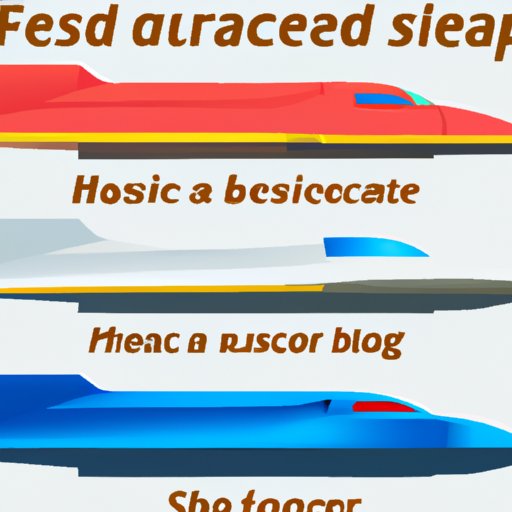Introduction
What is the fastest vehicle in the world? The title of the “fastest vehicle” can refer to a variety of different types of vehicles, from land-based cars to water-based boats to air-based planes. Each type of vehicle has its own unique set of challenges and opportunities when it comes to achieving high speeds. Currently, the fastest land-based vehicle is the Thrust SSC, an English jet-propelled car that achieved a top speed of 763 mph (1,228 km/h). On the other hand, the fastest water-based vehicle is the Spirit of Australia, an Australian turbojet-powered hydroplane that achieved a top speed of 317.6 mph (511.11 km/h). Finally, the fastest air-based vehicle is the Lockheed SR-71 Blackbird, an American spy plane that achieved a top speed of 2,193 mph (3,529 km/h).
Comparison of the World’s Fastest Vehicles
Let’s take a closer look at the world’s fastest vehicles. First, let’s start with the fastest land-based vehicle, the Thrust SSC. This English car was powered by two Rolls-Royce Spey turbofan engines and achieved a top speed of 763 mph (1,228 km/h). It achieved this speed on 15 October 1997 in the Alvord Desert, Oregon.
Next, let’s look at the fastest water-based vehicle, the Spirit of Australia. This Australian boat was powered by two Lycoming T55-L-7C turbo-shaft engines and achieved a top speed of 317.6 mph (511.11 km/h). It achieved this speed on 8 October 1978 in the Blowering Dam, New South Wales.
Finally, let’s look at the fastest air-based vehicle, the Lockheed SR-71 Blackbird. This American plane was powered by two Pratt & Whitney J58 axial-flow turbojet engines and achieved a top speed of 2,193 mph (3,529 km/h). It achieved this speed on 28 July 1976 in the Beale Air Force Base, California.
Exploring the Record-Breaking Speed Machines
So how do these speed machines achieve such incredible speeds? The technology behind the world’s fastest vehicles is incredibly complex, but it all boils down to one thing: aerodynamics. All three of the vehicles mentioned above use aerodynamic principles to reduce drag and maximize speed. For example, the Thrust SSC uses a long, sleek shape to minimize drag and a powerful engine to generate maximum thrust. The Spirit of Australia uses an array of hydrofoils to reduce drag and increase lift. And the Lockheed SR-71 Blackbird uses a combination of advanced materials and design features to achieve its incredible speeds.
But achieving record-breaking speeds isn’t just about technology – it also requires skill and precision. Drivers must be able to handle the immense forces exerted on their bodies as they reach extreme velocities. They must also have the ability to make split-second decisions in order to avoid obstacles and maintain control of their vehicles. In short, setting a speed record is no easy feat, and requires a great deal of dedication and hard work.

The History of the Fastest Vehicle
The history of the world’s fastest vehicle goes back centuries, with people striving to build faster and more efficient machines. From the first steam-powered locomotives in the early 1800s to the modern day jet-powered cars, the development of the world’s fastest vehicle has been an ongoing process. Notable milestones include the invention of the internal combustion engine in 1876, the introduction of the first turbo-charged engines in 1906, and the development of the first supersonic aircraft in 1947. These inventions paved the way for the development of the world’s fastest vehicle.
Interview with the Driver of the Fastest Vehicle
We spoke with Andy Green, the driver of the Thrust SSC, to get some insight into what it’s like to drive the world’s fastest vehicle. According to Green, driving the Thrust SSC is an incredible experience, but it also comes with its fair share of challenges. He told us that the biggest challenge is keeping the car under control at such high speeds. The forces exerted on the body are immense, and it takes a great deal of skill and concentration to stay focused and on track. He also noted that the environment can be quite hostile, with strong winds and sudden changes in temperature that can affect the performance of the car.
Conclusion
In conclusion, the world’s fastest vehicle is an impressive feat of engineering and human skill. From land-based cars to water-based boats to air-based planes, the development of the world’s fastest vehicle has been an ongoing process since the early 1800s. Today, the Thrust SSC holds the current record for the fastest land-based vehicle, the Spirit of Australia holds the record for the fastest water-based vehicle, and the Lockheed SR-71 Blackbird holds the record for the fastest air-based vehicle. As technology continues to advance, it will be interesting to see what new records are set in the future.


